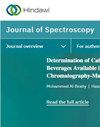Rapid Determination of Escherichia coli Concentration in Water Using Multiwavelength Transmission Spectroscopy
IF 2.1
4区 化学
Q4 BIOCHEMICAL RESEARCH METHODS
引用次数: 0
Abstract
Bacterial concentration is an important indicator to measure the degree of water pollution. Realizing rapid and accurate quantification of bacterial concentration in water is of great significance for ensuring water safety and maintaining human health. This paper proposes a method for rapid determination of bacterial concentration by multiwavelength transmission spectroscopy combined with partial least squares regression. Escherichia coli (E. coli) is selected because it is a common indicator microorganism for assessing water pollution status, and it is easy to handle. First, we measure the transmission spectra for E. coli suspensions in the region from 200 to 900 nm and analyze the differences in the spectral characteristics at different concentrations; subsequently, considering that the concentration is affected by the instrument linearity and other factors, the sensitivity, correlation, and detection ability of the spectra at different wavelengths with the change of concentration are analyzed, and the optimal characteristic band is selected according to its wavelength variation characteristics; finally, the determination of E. coli concentrations are completed by using the optimal characteristic band spectra combined with partial least squares regression. We calculate the bacterial concentration, compared with the plate counting, the maximum relative error is 4.500%, the average relative error is 0.677%, respectively, which is less than 5%, and their accuracy and stability are all better than those calculated by the single-wavelength method. This study provides a reference for the rapid and accurate detection of bacterial concentration in water.多波长透射光谱法快速测定水中大肠杆菌浓度
细菌浓度是衡量水体污染程度的重要指标。实现水中细菌浓度的快速、准确定量,对保障水体安全和维护人体健康具有重要意义。提出了一种多波长透射光谱法结合偏最小二乘回归快速测定细菌浓度的方法。选择大肠杆菌(e.c oli)是因为它是评价水污染状况的常用指示微生物,而且易于处理。首先,我们测量了大肠杆菌悬浮液在200 ~ 900 nm范围内的透射光谱,分析了不同浓度下的光谱特性差异;随后,考虑到浓度受仪器线性度等因素的影响,分析了不同波长光谱随浓度变化的灵敏度、相关性和检测能力,并根据其波长变化特征选择最佳特征波段;最后,利用最优特征谱结合偏最小二乘回归,完成了大肠杆菌浓度的测定。与平板计数法相比,计算出的细菌浓度最大相对误差为4.500%,平均相对误差为0.677%,均小于5%,其准确度和稳定性均优于单波长法。本研究为快速准确地检测水中细菌浓度提供了参考。
本文章由计算机程序翻译,如有差异,请以英文原文为准。
求助全文
约1分钟内获得全文
求助全文
来源期刊

Journal of Spectroscopy
BIOCHEMICAL RESEARCH METHODS-SPECTROSCOPY
CiteScore
3.00
自引率
0.00%
发文量
37
审稿时长
15 weeks
期刊介绍:
Journal of Spectroscopy (formerly titled Spectroscopy: An International Journal) is a peer-reviewed, open access journal that publishes original research articles as well as review articles in all areas of spectroscopy.
 求助内容:
求助内容: 应助结果提醒方式:
应助结果提醒方式:


